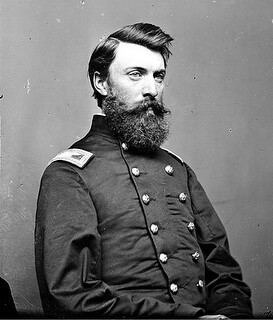Ezra A. Carman facts for kids
Quick facts for kids
Ezra Ayers Carman
|
|
|---|---|
 |
|
| Born | February 27, 1834 Oak Tree, New Jersey |
| Died | December 25, 1909 (aged 75) Washington, D.C. |
| Buried | |
| Allegiance | United States of America |
| Service/ |
United States Army Union Army |
| Years of service | 1860-1865 |
| Rank | |
| Commands held | 13th New Jersey Volunteer Infantry |
| Battles/wars | American Civil War |
| Other work | Civil Servant |
Ezra Ayers Carman (born February 27, 1834 – died December 25, 1909) was an important officer in the Union Army during the American Civil War. He led soldiers from New Jersey and sometimes commanded a larger group called a brigade.
Contents
Early Life and Education
Ezra Carman was born near Oak Tree, New Jersey. He was the oldest child of Melancthon F. Carman and Ann Maria Ayers. He went to school at the Kentucky Military Institute and the University of Nashville. After his studies, he became a merchant.
Serving in the Civil War
When the American Civil War began, Ezra Carman joined the Army in Newark, New Jersey. On September 19, 1861, he became a lieutenant colonel in the 7th New Jersey Volunteer Infantry.
First Battles and Injuries
During the Battle of Williamsburg on May 5, 1862, Carman was wounded in his right arm. After he recovered, he was promoted to colonel on July 8, 1862. He then helped create and lead the 13th New Jersey Volunteer Infantry.
Leading Troops in Major Battles
Colonel Carman led his regiment in many important battles.
- At the Battle of Antietam, he was part of a brigade led by Brig. Gen. George Henry Gordon.
- He also fought in the Battle of Chancellorsville and the Battle of Gettysburg. At Gettysburg, his troops were on the right side of the Union Army.
- Later that month, Carman led a temporary brigade. They were sent to help stop the New York Draft Riots.
Moving West with the Army
In late 1863, Carman and his troops moved west. They went to help the Army of the Cumberland during the Chattanooga Campaign. His regiment then joined the new XX Corps.
The Atlanta Campaign and March to the Sea
Carman served in the Atlanta Campaign, fighting in several battles. He led a brigade during Maj. Gen. William T. Sherman's famous March to the Sea. His corps became part of Maj. Gen. Henry W. Slocum's Army of Georgia.
After Savannah, Georgia, was captured, Carman was sent to Nashville for "special duty." He left the volunteer service on March 13, 1865. On the same day, he was given the honorary rank of Brevet brigadier general.
Life After the War
After the war, Ezra Carman worked for the government.
- From 1877 to 1885, he was the chief clerk for the United States Department of Agriculture.
- He became a historical expert for the board that created the Antietam National Battlefield.
- Later, he became the superintendent of the Chickamauga-Chattanooga National Battlefield.
Ezra Carman passed away in Washington, D.C. He is buried at the Arlington National Cemetery. He was survived by his second wife, Ada Salmon Carman, and four of their children.
Carman's Historical Work
Ezra Carman was also known for his historical studies.
- His maps can be found in the Atlas of the battlefield of Antietam.
- He wrote a detailed study about the Maryland Campaign. This book was published later as The Maryland Campaign of September 1862: Ezra A. Carman's Definitive Study of the Union and Confederate Armies at Antietam.
- He also co-authored a report on the history of the sheep industry in the United States.
- Carman helped research his family history for the "Carman Association." His personal papers are kept at the New Jersey Historical Society, the New York Public Library, and the National Archives.

